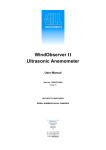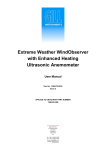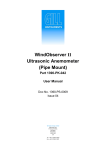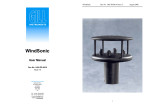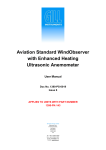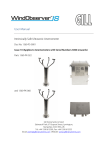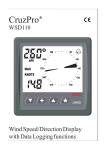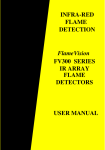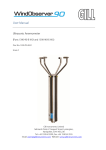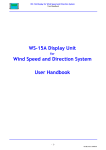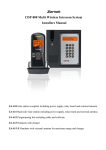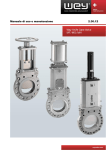Download Intrinsically Safe WindObserver Anemometer
Transcript
Intrinsically Safe WindObserver Anemometer User Manual Doc No. 1360-PS-0001 Issue 03 Gill Instruments Ltd recognise all trademarks Gill Instruments Limited Saltmarsh Park, 67 Gosport Street, Lymington, Hampshire. SO41 9EG UK Tel: +44 (0) 1590 613500 Fax: +44 (0) 1590 613501 E-mail: [email protected] Website: www.gill.co.uk Gill Instruments Ltd _______________________________________________________________________________________________________ Intrinsically Safe WindObserver Anemometer Doc. No. 1360-PS-0001 Page 1 Issue 03 September 2002 Gill Instruments Ltd _______________________________________________________________________________________________________ WARNING: ENSURE CORRECT SUPPLY VOLTAGE IS SELECTED ON POWER SUPPLY BEFORE INSTALLATION Intrinsically Safe WindObserver Anemometer Doc. No. 1360-PS-0001 Page 2 Issue 03 September 2002 Gill Instruments Ltd _______________________________________________________________________________________________________ 1. FOREWORD................................................................................................................................................5 2. PACKING LIST...........................................................................................................................................5 3. INSTALLATION.........................................................................................................................................6 3.1 Mounting................................................................................................................................................6 3.2 Alignment...............................................................................................................................................6 3.3 Sealing....................................................................................................................................................6 3.4 Corrosion................................................................................................................................................6 3.5 Earthing..................................................................................................................................................6 3.6 Cabling....................................................................................................................................................6 3.7 General....................................................................................................................................................6 4. SYSTEM OPERATION...............................................................................................................................7 4.1 Wind Measurement ................................................................................................................................7 4.1.1 Measurement Sampling Rates and Averages...................................................................................7 4.2 System Configuration.............................................................................................................................7 4.3 Default System Configuration................................................................................................................7 5. CONNECTION TO A PC OR OTHER DEVICE........................................................................................8 6. USING THE ANEMOMETER WITH A COMPUTER AND YOUR SOFTWARE..................................9 6.1 Digital Serial Output Formats.................................................................................................................9 6.2 Digital Format Notes............................................................................................................................12 6.3 Status Code...........................................................................................................................................12 7. ANEMOMETER SOFTWARE COMMANDS.........................................................................................14 7.1 Configuration Mode.............................................................................................................................14 7.2 Polled Operation...................................................................................................................................14 7.3 Output Mode.........................................................................................................................................14 7.4 Output Units.........................................................................................................................................14 7.5 Measurement Average..........................................................................................................................14 7.6 Output String Padding..........................................................................................................................14 7.7 Baud Rate.............................................................................................................................................15 7.8 Sample Period.......................................................................................................................................15 7.9 Parity.....................................................................................................................................................15 7.10 Vertical Padding.................................................................................................................................15 7.11 Unit Identification...............................................................................................................................15 7.12 Diagnostics.........................................................................................................................................15 8. DRAWINGS...............................................................................................................................................16 1086-G-045 Anemometer Installation Details...........................................................................................17 1360-G-026 Type IIc I.S. Anemometer Dimensions.................................................................................18 1360-G-028 I.S. WindObserver II System Diagram Sheet 1 of 2..............................................................19 1360-G-028 I.S. WindObserver II System Diagram Sheet 2 of 2..............................................................20 1360-M-039 I.S.Terminal Arrangement.....................................................................................................21 1360-G-043 I.S. PCI Unit...........................................................................................................................22 9.1 Specification.........................................................................................................................................23 10. POWER AND COMMUNICATIONS INTERFACE..............................................................................25 10.1 PCI......................................................................................................................................................25 10.1.1 External Connections...................................................................................................................25 10.1.2 Electrical Power Requirements....................................................................................................25 10.1.3 Internal Supply ...........................................................................................................................25 10.1.4 External Supply ...........................................................................................................................25 10.1.5 RS422 Interface...........................................................................................................................25 10.1.6 Cable Requirements.....................................................................................................................25 10.1.7 Environmental..............................................................................................................................26 10.1.8 Material........................................................................................................................................26 10.1.9 EMC.............................................................................................................................................26 APPENDIX 1..................................................................................................................................................27 SUMMARY OF ABBREVIATIONS USED IN THIS MANUAL...........................................................27 OPTIONAL EXTRAS................................................................................................................................29 Intrinsically Safe WindObserver Anemometer Doc. No. 1360-PS-0001 Page 3 Issue 03 September 2002 Gill Instruments Ltd _______________________________________________________________________________________________________ APPENDIX 2..................................................................................................................................................30 PRODUCT APPROVALS.........................................................................................................................30 SIRA CERTIFICATION........................................................................................................................30 Intrinsically Safe WindObserver Anemometer Doc. No. 1360-PS-0001 Page 4 Issue 03 September 2002 Gill Instruments Ltd _______________________________________________________________________________________________________ 1. FOREWORD This manual refers to the Gill Instruments Ltd Intrinsically Safe WindObserver ultrasonic anemometer. It is an extremely sophisticated instrument and to achieve optimum performance we recommend that you read the whole of this manual before proceeding further with use. The Solent range is in continuous development and so specifications may be subject to change without prior notice. 2. PACKING LIST • • • • • • Intrinsically Safe 2 axis anemometer Mounting kit This manual Intrinsically Safe Power & Communications Interface Anemometer Connector 20 way 3m Anemometer Cable Intrinsically Safe WindObserver Anemometer Doc. No. 1360-PS-0001 Page 5 Issue 03 September 2002 Gill Instruments Ltd _______________________________________________________________________________________________________ 3. INSTALLATION 3.1 Mounting The Anemometer should be mounted on a suitable surface as defined in drawing 1086-G045 shown in Section 8, using the mounting kit supplied and described in the Packing List. The anemometer does not require any adjustment - do not attempt to dismantle, or warranty and calibration will be void. 3.2 Alignment The anemometer should be set to point North, see drawing 1360-G-026 as shown in Section 8, (or to some other known reference direction). This is facilitated by slots in the base for the mounting screws, which allow rotation of the anemometer for fine alignment. 3.3 Sealing The connector area at the base of the anemometer should not be directly exposed to moisture or solvents, as whilst the connectors are sealed when mated, the anemometer is vented to air at the base to avoid pressure build up. Therefore use the gasket provided in the mounting kit. 3.4 Corrosion Careful note should be taken of the possibility of galvanic corrosion by incorrect mounting. It is vital that only stainless steel fixings are used and that the instrument is insulated from the mounting surface with the rubber gasket. This will ensure that the anemometer will provide long service under extreme conditions. 3.5 Earthing The system must be earthed in accordance with local or national regulations. Intrinsically safe operation will be affected if incorrectly earthed. 3.6 Cabling Ensure that strain relief measures are employed when installing the cables. Do not allow the whole weight of the cable to be applied to the connector. 3.7 General DO NOT attempt to remove or unscrew any fixing. Any unauthorised adjustment of the unit could affect intrinsic safety and will void the warranty. The unit must be installed in accordance with the Control Drawing 1360-G-028, Section 8. Intrinsically Safe WindObserver Anemometer Doc. No. 1360-PS-0001 Page 6 Issue 03 September 2002 Gill Instruments Ltd _______________________________________________________________________________________________________ 4. SYSTEM OPERATION There are two modes of operation, as follows: Wind measurement Normal operating mode System configuration Used to reconfigure system. See Section 7. 4.1 Wind Measurement This is the normal operating mode. Data is output once per second or four times per second. 4.1.1 Measurement Sampling Rates and Averages There are two sampling rates: 1) One output per second 50ms sample rate - block average of 19 measurements / output. 2) Four outputs per second 50ms sample rate - block average of 4 measurements / output. The block averages of 19 and 4 measurements are due to the last sample period being required for measurement scaling and output formatting. 4.2 System Configuration This mode will allow the user to configure the anemometer via the RS422 interface. It is entered and exited by transmitting control characters to the anemometer, see Section 7. The system will then expect a single character and number sequence which will change mode, wind speed output etc. No security will be included in this mode, but only valid user entries will be accepted. See Section 7 for the full list of commands. 4.3 Default System Configuration The anemometer is factory configured as follows: P1: G1: M2: U1: B3: F1: NA: O1: V1: 1 output per second Averaging Off ASCII Polar Continuous m/s Baud rate set to 9600 8 data bits, no parity Poll address 'A' Comma Separated Variable output Vertical Padding Disabled Intrinsically Safe WindObserver Anemometer Doc. No. 1360-PS-0001 Page 7 Issue 03 September 2002 Gill Instruments Ltd _______________________________________________________________________________________________________ 5. CONNECTION TO A PC OR OTHER DEVICE Connection to a PC or other device requires the use of: 1) An Intrinsically Safe Power and Communications Interface (PCI) – MUST BE USED UNDER ALL CIRCUMSTANCES. 2) PCI to PC / Other device cable - Digital RS232 9 way “D Type” connector. The PCI supplies power to the anemometer electronics and provides conversion of the RS422 signal sent by the anemometer to the RS232 signal required by the PC. The PCI requires connection to the mains; for more details refer to Section 10. Computers other than IBM PCs or other compatibles may require a customised cable for connection to the PCI. The anemometer outputs wind data through a single 20 way circular connector in the base. Details of the pin allocations can be found in Section 9. Data is provided in Digital format. Baud rate options are: 1) 1200 2) 2400 3) 4800 4) 9600 5) 19200 6) 38400 Three serial data formats are available: 1) 1 start, 8 data, odd parity, 1 stop 2) 1 start, 8 data, even parity, 1 stop 3) 1 start, 8 data, no parity, 1 stop The selection of different baud rates and data formats require the user to confirm the selection so that the interface between the device and the anemometer cannot be set in a mode that is not valid for both units. Intrinsically Safe WindObserver Anemometer Doc. No. 1360-PS-0001 Page 8 Issue 03 September 2002 Gill Instruments Ltd _______________________________________________________________________________________________________ 6. USING THE ANEMOMETER WITH A COMPUTER AND YOUR SOFTWARE The user need not necessarily use a terminal emulator to store and analyse data being sent by the anemometer. This section describes the modes and format of the data output by the anemometer so that you can write your own software. 6.1 Digital Serial Output Formats There are five wind data modes in ASCII format, one in Binary format and one network identification response available from the serial output of the anemometer as follows: Mode 1 ASCII, UV, Continuous <STX><ID>,±UUU.UU,±VVV.VV,U,SS,<ETX>CC<CR><LF> where: <STX> Start of string character (ASCII value 2) <ID> Anemometer IDentification (A-Z) ±UUU.UU ‘U’ axis velocity (*1) ±VVV.VV ‘V’ axis velocity (*2) U Units (M=m/s, N=knots, P=mph, K=kph, F=fpm) SS Status data <ETX> End of string character (ASCII value 3) CC Checksum of all Characters between <STX> and <ETX> (HEX byte) <CR><LF> Carriage Return and LineFeed Mode 2 ASCII, Polar, Continuous <STX><ID>,DDD,MMM.MM,U,SS,<ETX>CC<CR><LF> where: <STX> Start of string character (ASCII value 2) <ID> Anemometer IDentification (A-Z) DDD Direction in degrees MMM.MM Wind Magnitude (*3) U Units (M=m/s, N=knots, P=mph, K=kph, F=fpm) SS Status data <ETX> End of string character (ASCII value 3) CC Checksum of all Characters between <STX> and <ETX> (HEX byte) <CR><LF> Carriage Return and LineFeed Intrinsically Safe WindObserver Anemometer Doc. No. 1360-PS-0001 Page 9 Issue 03 September 2002 Gill Instruments Ltd _______________________________________________________________________________________________________ Mode 3 ASCII, UV, Polled where: <STX><ID>,±UUU.UU,±VVV.VV,U,SS,<ETX>CC<CR><LF> <STX> Start of string character (ASCII value 2) <ID> Anemometer IDentification (A-Z) ±UUU.UU ‘U’ axis velocity (*1) ±VVV.VV ‘V’ axis velocity (*2) U Units (M=m/s, N=knots, P=mph, K=kph, F=fpm) SS Status data <ETX> End of string character (ASCII value 3) CC Checksum of all Characters between <STX> and <ETX> (HEX byte) <CR><LF> Carriage Return and LineFeed Mode 4 ASCII, Polar, Polled where: <STX><ID>,DDD,MMM.MM,U,SS,<ETX>CC<CR><LF> <STX> Start of string character (ASCII value 2) <ID> Anemometer IDentification (A-Z) DDD Direction in degrees MMM.MM Wind Magnitude (*3) U Units (M=m/s, N=knots, P=mph, K=kph, F=fpm) SS Status data <ETX> End of string character (ASCII value 3) CC Checksum of all Characters between <STX> and <ETX> (HEX byte) <CR><LF> Carriage Return and LineFeed (*1) In Feet Per Minute output mode, the string changes to ±UUUU.U (*2) In Feet Per Minute output mode, the string changes to ±VVVV.V (*3) In Feet Per Minute output mode, the string changes to MMMM.M Intrinsically Safe WindObserver Anemometer Doc. No. 1360-PS-0001 Page 10 Issue 03 September 2002 Gill Instruments Ltd _______________________________________________________________________________________________________ Mode 5 ASCII, UV, Polled, No Tri-State where: <STX><ID>,±UUU.UU,±VVV.VV,U,SS,<ETX>CC<CR><LF> <STX> Start of string character (ASCII value 2) <ID> Anemometer IDentification (A-Z) ±UUU.UU ‘U’ axis velocity (*1) ±VVV.VV ‘V’ axis velocity (*2) U Units (M=m/s, N=knots, P=mph, K=kph, F=fpm) SS Status data <ETX> End of string character (ASCII value 3) CC Checksum of all Characters between <STX> and <ETX> (HEX byte) <CR><LF> Carriage Return and LineFeed Mode 6 ASCII, NMEA, continuous where $IIMWV,Wc1,R,Wc2,Units,Valid,*cc<CR><LF> ‘$’ Start of string character ‘II’ Integrated instrument ‘MWV’ Mean wind direction and velocity Wc1 Wind component 1 ‘R’ Relative wind measurement Wc2 Wind component 2 Units Units ident Valid Valid flag ‘*’ Checksum delimiter cc Checksum Wind Component Fields Direction in degrees (DDD) Wc1 Wc2 Wind speed (MMM.MM) Units Field Value M N P K F Intrinsically Safe WindObserver Anemometer Doc. No. 1360-PS-0001 Units m/s Knots MPH kph FPM Page 11 Issue 03 September 2002 Gill Instruments Ltd _______________________________________________________________________________________________________ Valid Field ‘A’ ‘V’ Valid measurement Invalid measurement Checksum Field Exclusive OR of all characters between ‘$’ and ‘*’ reported as ASCII hex. 6.2 Digital Format Notes 1) If wind speed is too low to calculate direction (below 0.5m/s) then the direction parameter DDD, in ASCII modes, will remain blank in CSV mode. In fixed field mode, direction freezes at last valid direction. 2) The checksum is the EXCLUSIVE OR of the 8 data bits of each character between and excluding <STX> and <ETX>. The HEX value of the most significant and least significant four bits of the result are converted to 2 ASCII characters for transmission. 3) If the anemometer detects a checksum error in the non-volatile memory, the following ASCII string is output in place of the normal output: **NO CONFIGURATION DATA**<CR><LF>. 4) In fixed field mode an error will result in value +99.999 for UV and Magnitude and 999 for direction being reported. 6.3 Status Code A two character ‘Status code’ will be transmitted in the serial string. This value will denote the system and measurement status. The codes are: Code 00 - O.K. This indicates that the system is operating correctly. The transducers signals are within the required limits and no memory faults have occurred. Code 01 - Transducer Pair 1 Failed. This error occurs when there is a blockage in the path of transducer pair one, or when a transducer has failed. Code 02 - Transducer Pair 2 Failed. This error occurs when there is a blockage in the path of transducer pair two, or when a transducer has failed. Intrinsically Safe WindObserver Anemometer Doc. No. 1360-PS-0001 Page 12 Issue 03 September 2002 Gill Instruments Ltd _______________________________________________________________________________________________________ Code 04 - Transducer Pairs 1 and 2 Failed. This error occurs when there is a blockage in the path of transducer pairs one and two, or when transducers have failed. Code 08 - Non-Volatile Memory Checksum Error. The non-volatile memory (EEPROM) holds the user set up, internal system parameters and calibration data. If the internal checksum programmed in production does not match the one calculated by the system during operation, then this status code will be flagged. An EEPROM error could be caused by a faulty read/write cycle or a complete chip failure. Code 09 - Volatile Memory Checksum Error. The volatile memory (SRAM) holds the data, which is used during the vector calibration codes. If the internal checksum programmed in production does not match the one calculated during system operation then this status code is flagged. The unit is operating in uncalibrated mode. Code 10 - System Gain at Maximum. This indicates that an ultrasonic signal has been received but the receive gain had to be set to maximum to recover the pulse. This is normally due to partially blocked transducer paths. The wind velocity reported could be in error. Code 50 - Marginal System Gain Condition. This indicates that an ultrasonic signal has been received but a high receive gain was required to recover the pulse. This code is asserted during high wind velocities. It may also be caused by partially blocked transducer paths or partially failed transducers (low efficiency). The wind velocity reported will be correct. Code 51 - Measurement Average Building. This code is set before the average period selected (3, 5,10 or 15 seconds) has been reached. The reported velocities during this period are only the average calculated for the length of time that the unit has been operational. This code only occurs after a power on or exit from configuration mode. NOTE Should any of these status codes other than code 00 appear consistently then the unit will need to be returned to the manufacturer for repair. Intrinsically Safe WindObserver Anemometer Doc. No. 1360-PS-0001 Page 13 Issue 03 September 2002 Gill Instruments Ltd _______________________________________________________________________________________________________ 7. ANEMOMETER SOFTWARE COMMANDS 7.1 Configuration Mode On, Modes M1, M2 On, Modes M3, M4 Off * *x (Where x is polling identifier A-Z) Q 7.2 Polled Operation Request Identification Disable Polled Output Enable Polled Output Anemometer Poll & ! ? A-Z The unit will only accept the following commands when in configuration mode: 7.3 Output Mode ASCII, UV, Continuous ASCII, Polar, Continuous ASCII, UV, Polled ASCII, Polar, Polled ASCII, UV, Polled, No Tri-State ASCII, NMEA, Continuous M1 M2 M3 M4 M5 M6 7.4 Output Units m/s Knots MPH KPH FPM U1 U2 U3 U4 U5 7.5 Measurement Average Off 3 Second 5 Second 10 Second 15 Second G1 G2 G3 G4 G5 7.6 Output String Padding Off Comma Separated Variable On Fixed Field Intrinsically Safe WindObserver Anemometer Doc. No. 1360-PS-0001 O1 O2 Page 14 Issue 03 September 2002 Gill Instruments Ltd _______________________________________________________________________________________________________ 7.7 Baud Rate 2400 4800 9600 19200 38400 1200 B1 B2 B3 B4 B5 B6 7.8 Sample Period 1 Sample Per Second 4 Samples Per Second P1 P2 7.9 Parity 8 Data, No Parity 8 Data, Even Parity 8 Data, Odd Parity F1 F2 F3 7.10 Vertical Padding V1 - Vertical Padding with Zero Disabled V2 - Vertical Padding with Zero Enabled The following are only applicable in modes 3&4. 7.11 Unit Identification Set Identification to ‘x’ Nx 7.12 Diagnostics Read Serial Number and Type Read S/W Version Read System Configuration D1 D2 D3 REFER ALSO TO SECTION 6.3 Intrinsically Safe WindObserver Anemometer Doc. No. 1360-PS-0001 Page 15 Issue 03 September 2002 Gill Instruments Ltd _______________________________________________________________________________________________________ 8. DRAWINGS Intrinsically Safe WindObserver Anemometer Doc. No. 1360-PS-0001 Page 16 Issue 03 September 2002 Gill Instruments Ltd _______________________________________________________________________________________________________ 1086-G-045 Anemometer Installation Details . Intrinsically Safe WindObserver Anemometer Doc. No. 1360-PS-0001 Page 17 Issue 03 September 2002 Gill Instruments Ltd _______________________________________________________________________________________________________ 1360-G-026 Type IIc I.S. Anemometer Dimensions Intrinsically Safe WindObserver Anemometer Doc. No. 1360-PS-0001 Page 18 Issue 03 September 2002 Gill Instruments Ltd _______________________________________________________________________________________________________ 1360-G-028 I.S. WindObserver II System Diagram Sheet 1 of 2 Intrinsically Safe WindObserver Anemometer Doc. No. 1360-PS-0001 Page 19 Issue 03 September 2002 Gill Instruments Ltd _______________________________________________________________________________________________________ 1360-G-028 I.S. WindObserver II System Diagram Sheet 2 of 2 Intrinsically Safe WindObserver Anemometer Doc. No. 1360-PS-0001 Page 20 Issue 03 September 2002 Gill Instruments Ltd _______________________________________________________________________________________________________ 1360-M-039 I.S.Terminal Arrangement Intrinsically Safe WindObserver Anemometer Doc. No. 1360-PS-0001 Page 21 Issue 03 September 2002 Gill Instruments Ltd _______________________________________________________________________________________________________ 1360-G-043 I.S. PCI Unit Intrinsically Safe WindObserver Anemometer Doc. No. 1360-PS-0001 Page 22 Issue 03 September 2002 Gill Instruments Ltd _______________________________________________________________________________________________________ 9. TECHNICAL SPECIFICATION 9.1 Specification I.S. Rating - European For use in Zone 0, 1 and 2 Areas. Rating EEx ia (BS EN 50 020) Gas Group IIC Temp Class T5 Measurement Characteristics Measurement velocity range 0 to 70m/s Velocity resolution 0.01m/s Velocity accuracy ±5% RMS Direction resolution 1 degree Direction accuracy ± 4 degrees Note: Accuracy specification applies from 5oC to 35oC and for wind incidence within ±10o of horizontal. Temperature Characteristics Operating -25oC to +60oC Storage -50oC to +75oC Anem. Electrical Supply Current 6 to 12V DC 30mA Peak All circuits protected to 0.8 Joule Environmental Altitude Humidity Moisture ingress 0 to 3000m 5 to 100% RH IP65 EMC Emissions Immunity BS EN 50081-1:1992 (class B) BS EN 50082-1:1992 Material 316 Stainless Steel Intrinsically Safe WindObserver Anemometer Doc. No. 1360-PS-0001 Page 23 Issue 03 September 2002 Gill Instruments Ltd _______________________________________________________________________________________________________ Serial Interface One Tx RS422 channel One Rx RS422 channel 1200, 2400, 4800, 9600, 19200 and 38400 baud Parity error check available (odd or even) Serial output rate 1 per second or 4 per second Physical Size Weight 380mm x 210mm 2kg Connector Hirose, 20 way socket Connector pin Designation 1 Not Used 2 RS422_TXB 3 RS422_TXA 4 RS422_RXB 5 RS422_RXA 6 Supply V+ 7 Not Used 8 Not Used 9 Not Used 10 Not Used 11 Not Used 12 Not Used 13 Not Used 14 Supply V15 Not Use 16 Not Used 17 Not Used 18 Not Used 19 Not Used 20 Not Used Intrinsically Safe WindObserver Anemometer Doc. No. 1360-PS-0001 (+) (-) (+) (-) Page 24 Issue 03 September 2002 Gill Instruments Ltd _______________________________________________________________________________________________________ 10. POWER AND COMMUNICATIONS INTERFACE The Intrinsically Safe anemometer must be operated with the intrinsically safe power and communications interface (PCI). 10.1 PCI For use with single intrinsically safe anemometers. 10.1.1 External Connections Earth Post Mains Connector Anemometer Connector RS232 Connection RS422 Connection 10.1.2 Electrical Power Requirements 1) 100Vac - 120Vac, 10VA for the 115V switch position. 2) 200Vac - 250Vac, 10VA for the 230V switch position. 10.1.3 Internal Supply Supply to the interface circuit 5V, 50mA 10.1.4 External Supply Supply via the intrinsically safe barrier Internal fuse 10.5V, 50mA 100mA 10.1.5 RS422 Interface Standard RS422 interface drivers are connected to the anemometer via zener barriers or galvanic isolation. One is used for the TX pair and the other for the RX pair. For Connector Pin and Cable Assignments please refer to Section 8, Drawing 1360-G028. 10.1.6 Cable Requirements Anemometer The anemometer is supplied with a 3-Meter long 3 pair 24 AWG screened cable. This should be terminated into an EExe approved junction box. The cable is 9mm in diameter, so a suitable gland should be fitted. The cable between the anemometer and the PCI should be a 3 pair screened and / or armoured, and have a minimum of 0.75mm cross sectional area and a maximum of 2.5mm cross sectional area. Do not attach the screen of the anemometer to earth at the junction box, it must be attached to terminals 19 and 20 of the PCI via the field cable screen. If armour cable is used the armour must be connected to earth. DO NOT join to the cable screen. Intrinsically Safe WindObserver Anemometer Doc. No. 1360-PS-0001 Page 25 Issue 03 September 2002 Gill Instruments Ltd _______________________________________________________________________________________________________ 10.1.7 Environmental Humidity 5 to 90% RH Moisture Ingress IP65 10.1.8 Material 316 Stainless Steel 10.1.9 EMC Emissions Immunity BS EN 50081-1:1992 BS EN 50082-1:1992 Intrinsically Safe WindObserver Anemometer Doc. No. 1360-PS-0001 Page 26 Issue 03 September 2002 Gill Instruments Ltd _______________________________________________________________________________________________________ APPENDIX 1 SUMMARY OF ABBREVIATIONS USED IN THIS MANUAL AC Alternating Current ANEM Anemometer ASCII American Standard Code for Information Interchange CR Carriage Return CSV Comma Separated Variable CSA Cross Sectional Area CTS Clear To Send DC Direct Current DCD Data Carrier Detect DDD Direction parameter DEG DEGrees DSR Data Set Ready DTR Data Terminal Ready EEPROM Electrically Erasable Programmable Read Only Memory EMC Electro-Magnetic Compatibility ETX End of string character FPM Feet Per Minute GND GrouND HEX Hexadecimal HZ Hertz IP65 Ingress Protection Classification Intrinsically Safe WindObserver Anemometer Doc. No. 1360-PS-0001 Page 27 Issue 03 September 2002 Gill Instruments Ltd _______________________________________________________________________________________________________ I.S Intrinsic Safety K Kilometres per hour Knots Nautical Measurement of speed KM KiloMetre KPH KiloMetres Per Hour LF Line Feed M3 Operating Mode 3 M4 Operating Mode 4 mA MilliAmperes MPH Miles Per Hour mm MilliMetres ms MilliSecond m/s Metres per Second pc IBM PC or compatible computer PCI Power and Communications Interface POR Power On Reset PROCOMM Terminal emulator software package RH Relative Humidity RMS Root Mean Squared RS232 Communications standard RS422 Communications standard RTS Request To Send RI Ring Initiate Intrinsically Safe WindObserver Anemometer Doc. No. 1360-PS-0001 Page 28 Issue 03 September 2002 Gill Instruments Ltd _______________________________________________________________________________________________________ RX Receive SEC SECond SRAM Static Random Access Memory STX Start of string character S/W SoftWare TX Transmit UV Cartesian Co-ordinate System V Volts V+ positive Voltage V- negative Voltage VA VoltAmperes OPTIONAL EXTRAS Custom software on application. Intrinsically Safe WindObserver Anemometer Doc. No. 1360-PS-0001 Page 29 Issue 03 September 2002 Gill Instruments Ltd _______________________________________________________________________________________________________ APPENDIX 2 PRODUCT APPROVALS SIRA CERTIFICATION 1. 2. Certificate Number; Sira 00ATEX2217 for the IS WindObserver Power Supply Unit 1360 Certificate Number: Sira 00ATEX2218 for the model 1360 IS WindObserver Anemometer Intrinsically Safe WindObserver Anemometer Doc. No. 1360-PS-0001 Page 30 Issue 03 September 2002 Gill Instruments Ltd _______________________________________________________________________________________________________ Intrinsically Safe WindObserver Anemometer Doc. No. 1360-PS-0001 Page 31 Issue 03 September 2002 Gill Instruments Ltd _______________________________________________________________________________________________________ Intrinsically Safe WindObserver Anemometer Doc. No. 1360-PS-0001 Page 32 Issue 03 September 2002 Gill Instruments Ltd _______________________________________________________________________________________________________ Intrinsically Safe WindObserver Anemometer Doc. No. 1360-PS-0001 Page 33 Issue 03 September 2002 Gill Instruments Ltd _______________________________________________________________________________________________________ Intrinsically Safe WindObserver Anemometer Doc. No. 1360-PS-0001 Page 34 Issue 03 September 2002 Gill Instruments Ltd _______________________________________________________________________________________________________ Intrinsically Safe WindObserver Anemometer Doc. No. 1360-PS-0001 Page 35 Issue 03 September 2002 Gill Instruments Ltd _______________________________________________________________________________________________________ Intrinsically Safe WindObserver Anemometer Doc. No. 1360-PS-0001 Page 36 Issue 03 September 2002





































